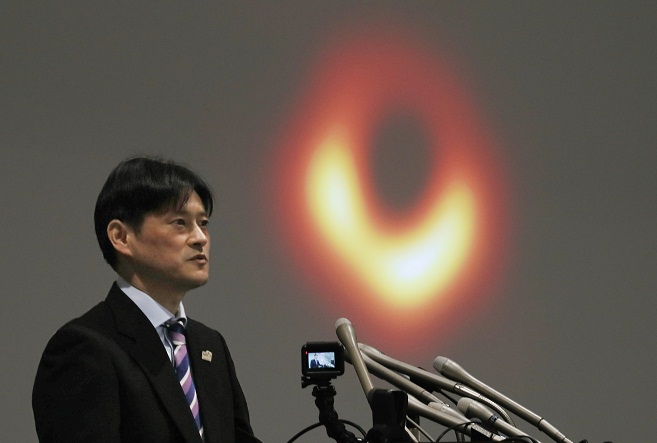First in history, international project captures image of black hole
April 11, 2019
Tokyo--For the first time in human history, an international team has succeeded in capturing an image of a black hole, through observations using eight radio telescopes on the globe, including the ALMA telescope in Chile.
Hopes are growing that the breakthrough will help understand black holes, mysterious astronomical objects with enormous masses but extremely compact sizes.
The black hole shown in the image is located at the heart of Messier 87, a massive galaxy in the nearby Virgo galaxy cluster, members of the Event Horizon Telescope project participated by institutions from Japan, the United States, Europe and others announced on Wednesday. The black hole resides 55 million light years from Earth and has a mass 6.5 billion times that of the sun, according to the team.
"We have taken the first picture of a black hole," said EHT project director Sheperd Doeleman of the Center for Astrophysics, Harvard and Smithsonian. "This is an extraordinary scientific feat accomplished by a team of more than 200 researchers."
The EHT used a technique called very-long baseline interferometry (VLBI), which synchronizes telescopes around the globe and exploits Earth's rotation to form a huge Earth-sized virtual telescope with unprecedented sensitivity and resolution.
In April 2017, the project observed black holes, including that in the Messier 87 galaxy, using eight radio telescopes linked based on the VLBI method.
After two years of work to analyze data obtained through the technique that can even recognize a golf ball placed on the surface of the moon from Earth, the project captured the image of the black hole located in a glowing ring of gas at the center of Messier 87, according to the team.
The telescopes used in the project other than ALMA were APEX in Chile, the IRAM 30-meter telescope in Spain, the James Clerk Maxwell Telescope in Hawaii, the Large Millimeter Telescope Alfonso Serrano in Mexico, the Submillimeter Array in Hawaii, the Submillimeter Telescope in Arizona and the South Pole Telescope in Antarctica.
From Japan, institutions, including the National Astronomical Observatory of Japan, Tohoku University and Hiroshima University, participated in the EHT project.
A German astronomer in 1914 predicted the existence of black holes, based on Albert Einstein's general relativity.
Even light cannot escape from a black hole due to its strong gravitational effects, and observations of a black hope itself are impossible.
While scientists around the world have observed substances, such as X-ray released from a disc of gas and other matters around black holes, efforts to observe black holes had been unsuccessful, due to insufficient sensitivity and resolution.
Latest Videos
- THE UNTOLD STORY EXPERT INSIGHTS INTO THE UKRAINE
- NEGOTIATING A NEW ORDER US RUSSIA TALKS ON UKRAIN
- Ukraine: A Pawn in the Geopolitical Game? Will Trump Intervene?
- US VP VANCE CRITICIZES EUROPEAN DEMOCRACIES AT MUNICH SECURITY CONFERENCE
- UNCOVERING THE WEB OF DECEIT: CIA INFILTRATION OF THE MEDIA
- SHIFTING SANDS: TULSI GABBARD’S CONFIRMATION AND THE EVOLVING GLOBAL LANDSCAPE
- FAUCI SCANDAL: A THREAT TO GLOBAL HEALTH AND DEMOCRACY






